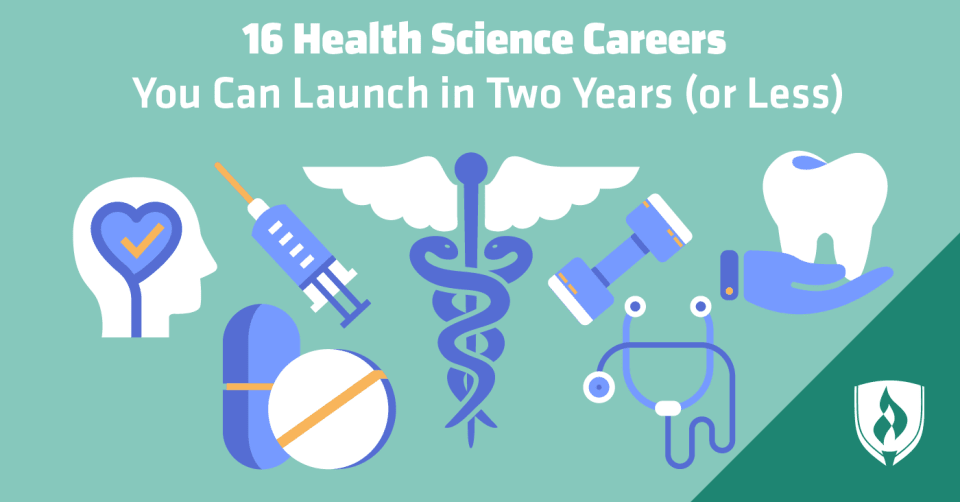
It’s no secret that the medical field generally offers stable careers with bright job outlooks. But entering the healthcare industry seems daunting. Medical professionals need so much specialized knowledge to care for patients, and you don’t have the resources to spend half a decade in school!
You might be surprised to learn that many health science careers don’t require a lengthy education at all. We used Bureau of Labor Statistics (BLS) data to round up 16 health science careers that are growing at a rate faster than the national average—and that you can launch in two years or less.1
Take a look at these health science careers to see whether one of them catches your eye.
16 In-demand health science careers you can launch in two years
Get a taste of the wide variety of careers in health science. Determine which ones best align with your skills and interests.
1. Home health aide
Required education: High school diploma1
Projected employment growth (2016 – 2026): 41 percent1
Home health aides visit patients in their own homes to provide care and assistance with daily tasks. Their medical duties could include administering medication, recording vital signs, changing dressings and reporting a patient’s progress to their physician. Home health aides may also help with household tasks such as laundry, light cleaning and delivering groceries.
2. Physical therapist assistant
Required education: Associate’s degree1
Projected employment growth (2016 – 2026): 31 percent1
Physical therapist assistants are part of a fast-growing medical specialty that focuses on helping patients regain movement after injury or illness. They work with physical therapists to educate patients, help patients perform specific exercises and use massage or stretching to improve patients’ mobility and manage pain.
3. Medical assistant
Required education: Postsecondary non-degree award1
Projected employment growth (2016 – 2026): 29 percent1
Medical assistants work in hospitals and clinics to record vital signs and medical histories, assist physicians with examinations, administer injections and medications, and prepare patients for procedures like X-rays. This hands-on healthcare career could be the right opportunity for someone who wants to be part of the routine care that’s vital in healthcare facilities.
4. Occupational therapy assistant
Required education: Associate’s degree1
Projected employment growth (2016 – 2026): 28 percent1
Occupational therapy assistants work with patients to perform therapeutic exercises designed to help them improve or recover the skills they need to live and work. Occupational therapy assistants teach patients how to use special equipment and how to properly perform stretches and exercises. They may also work with children to improve coordination and socialization.
5. Dental assistant
Required education: Postsecondary non-degree award1
Projected employment growth (2016 – 2026): 19 percent1
You’re probably familiar with dental assistants as the medical professionals who help care for your teeth at your yearly dentist visits. They take X-rays, prepare patients for procedures, polish teeth and apply fluoride. This growing career field could be for you if you would enjoy a variety of job duties and working closely with others on a healthcare team.
6. Human service assistant
Required education: High school diploma1
Projected employment growth (2016 – 2026): 16 percent1
Human service assistants work with clients to connect them with the resources and benefits they need, including medical care. They coordinate services, help clients complete paperwork, apply for eligible medical benefits and check in to ensure their clients are receiving the services they need. Human service assistants often work with children, the elderly and people struggling with mental illness or addiction.
7. Medical administrative assistant
Required education: Postsecondary non-degree award1
Projected employment growth (2016 – 2026): 15 percent1
These healthcare professionals, also called medical secretaries, are responsible for greeting patients, scheduling appointments, maintaining medical records and performing other clerical duties. Consider a medical administrative assistant career if you enjoy being around people but aren’t sure whether you’re cut out for direct patient care.
8. Registered nurse (RN)
Required education: Associate’s degree1
Projected employment growth (2016 – 2026): 15 percent1
RNs observe and monitor a patient’s condition and consult with physicians on a patient’s care. Many RNs have specific job duties related to their medical specialty, such as neonatal care, oncology or public health. Consider becoming an RN if you’re interested in direct patient care but want the freedom to explore other medical specialties.
9. Health information technician
Required education: Postsecondary non-degree award or Associate’s degree1
Projected employment growth (2016 – 2026): 13 percent1
Health information technicians (HIT) maintain and organize patients’ medical data, such as health history, test results, medications and visit summaries. They also follow regulations for electronic health records to maintain patient privacy. Consider this health science specialty if you have a knack for organization and want to help patients without providing direct care.
10. Medical coder
Required education: Postsecondary non-degree award1
Projected employment growth (2016 – 2026): 13 percent1
Medical coders use a special set of codes to translate patient visits and diagnoses into language insurance companies can understand. Their work is important so that patients and insurance are billed correctly and so that patients’ electronic health records are accurate. Medical coding could be for you if you have a knack for computer skills and don’t shy away from research.
11. Medical lab technician
Required education: Associate’s degree1
Projected employment growth (2016 – 2026): 13 percent1
Medical lab technicians are the healthcare specialists who collect blood or tissue samples and analyze them according to physicians’ directions. They operate and maintain specialized equipment to perform their tests, and they meticulously log their findings to ensure accuracy. If you’re detail-oriented and not squeamish around blood, this could be the medical career for you.
12. Radiologic technologist
Required education: Associate’s degree1
Projected employment growth (2016 – 2026): 12 percent1
Radiologic technologists perform diagnostic imaging, like X-rays and MRIs, on patients. Radiologic techs maintain equipment, prepare patients for imaging and protect patients from harmful radiation. They may also collaborate with physicians to read the images.
13. Licensed practical nurse (LPN)
Required education: Postsecondary non-degree award1
Projected employment growth (2016 – 2026): 12 percent1
Licensed practical nurses are hard-working healthcare professionals who work under the direction of a registered nurse or physician to provide patient care. An LPN’s duties vary by state, but they can typically be found monitoring and recording patients’ health and performing basic care like changing bandages. If you’re intrigued by the nursing field, becoming an LPN is an option that allows you to get your start without as much schooling as an RN.
14. Pharmacy technician
Required education: High school diploma or certificate1
Projected employment growth (2016 – 2026): 12 percent1
Pharmacy techs work under the supervision of pharmacists to prepare prescriptions for patients. They’re responsible for accurately measuring medication according to a physician’s instructions, managing inventory and restocking prescriptions. Pharmacy techs also process insurance claims and provide customer service to patients in person and on the phone.
15. Surgical technologist
Required education: Postsecondary non-degree award1
Projected employment growth (2016 – 2026): 12 percent1
Surgical technologists assist in operating rooms, where they prep the OR, sterilize equipment and pass instruments to the surgeon. These medical professionals must be detail-oriented as they carefully disinfect surfaces to prevent infection, and their compassion and empathy come into play when they prepare patients for surgery.
16. Certified nursing assistant (CNA)
Required education: High school diploma or postsecondary non-degree award1
Projected employment growth (2016 – 2026): 11 percent1
Certified nursing assistants provide basic care—such as feeding, bathing and transferring from a bed to a wheelchair—to patients in hospitals or nursing homes. They listen to patients’ concerns and communicate their needs to doctors and nurses on the healthcare team. CNAs may develop close camaraderie with the patients in their care, so this could be a great career option if you’re looking to connect with patients over a longer period of time.
Time to launch your health science career
Now you know there are plenty of options for fast-growing health science careers you can start in two years or less. If you’re ready to get started as soon as possible, check out Rasmussen University’s Health Sciences programs to learn how to take the first step!
1Bureau of Labor Statistics, U.S. Department of Labor, Occupational Outlook Handbook, [information accessed February 18, 2019] www.bls.gov/ooh/. Employment conditions in your area may vary. Completion time is dependent on transfer credits accepted and the number of courses completed each term.




